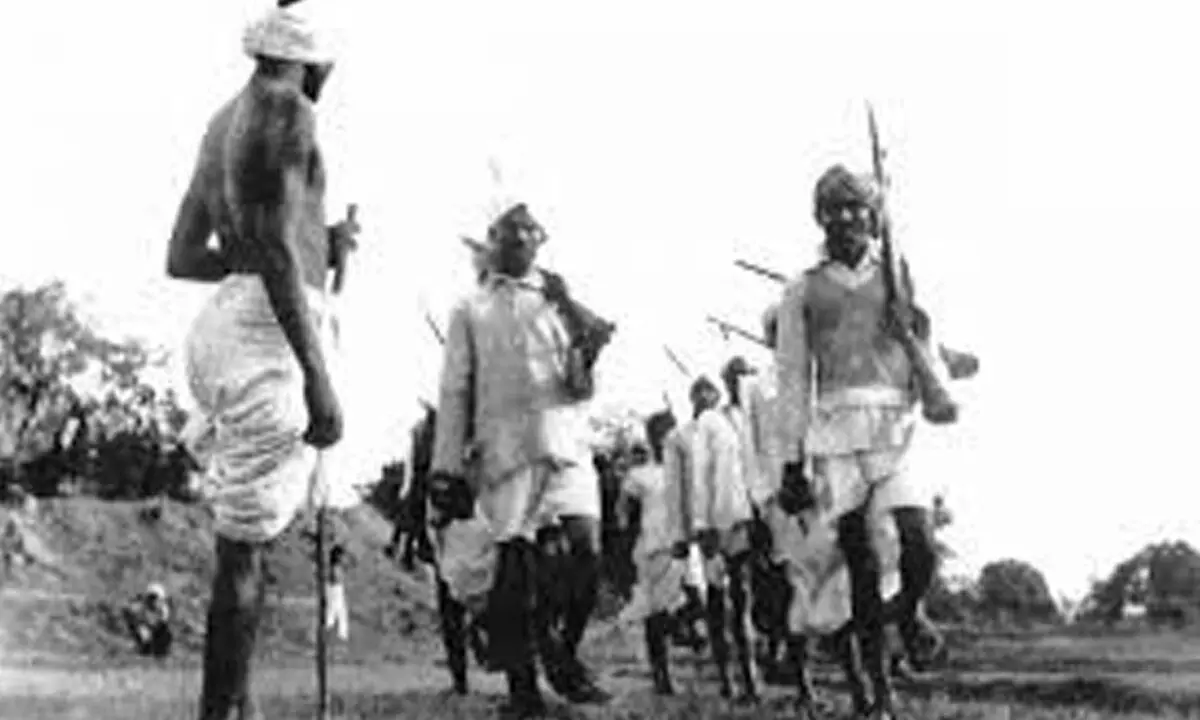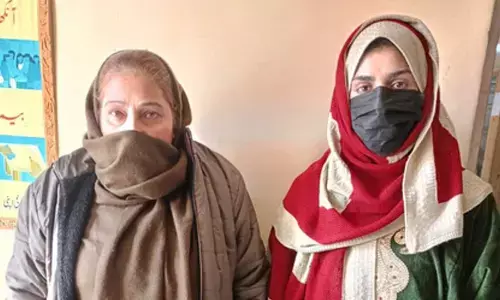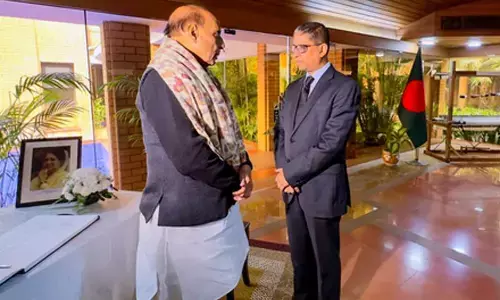It's merger, not liberation

It's merger, not liberation
There is a need to study deeply the reasons that prompted different sections of society to support the Telangana Armed Struggle
The Telangana Armed Struggle against the Nizam's autocracy in 1947 was an important historical event as the Nizam declared Hyderabad as an independent country in connivance with the British on September 11, 1947.
The Communist Party of India (CPI) gave a clarion call to the people to take up arms against the Nizam of Hyderabad Samsthan and for the merger of Hyderabad into the Indian Union. Comrades Ravi Narayan Reddy, Baddam Yella Reddy and Makhdoom Mohiuddin signed the statement on behalf of CPI, Andhra Mahasabha and All Hyderabad Trade Union Congress.
The freedom struggle of India had many streams. The main battle was fought in British India, which was directly ruled by the British. There were 545 small and big Samsthans, kingdoms which were ruled by native kings under the British umbrella. They were free only to exploit, torture the people in their kingdoms, but had to pay huge amounts to the British Crown for being allowed to exist. In fact, it was not a small mercy. But for the British, they would have been thrown out by the people long back.
The Hyderabad state was the biggest of the Samsthans. Half the districts were Telugu speaking, five Marathi speaking and three were Kannada districts. It was a prison of languages. Only Urdu was the official language and medium of instruction. The land was concentrated in the hands of big Deshmukhs and landlords. Some of them used to own one lakh to one-and-a-half lakh acres of land as well. There was the 'vetti' system, that is, officially all the people had to work for the landlords without wages. It was almost half-slavery. There were no civil and human rights. It was naturally hated by the people. But they were helpless.
The nationalist movement, led by the Indian National Congress, did not try to extend its struggle in the native states, probably with an expectation of support from them sometime or other. "Fight against Foreign Colonialism" was limited to the fight against the white skins. In fact, the native rulers were supporting the British with all their might. They were more loyal to the British than the British servants and soldiers.
But the light of the freedom struggle did reach the dark parts of the Samsthans but roused hopes among the people. There were heroic armed struggles against autocratic rules in Travancore-Cochin, Jammu and Kashmir, Manipur and other areas. The 1942 'Quit India' Movement, the Second World War and its consequences, the INA battle, the revolt of the RIN at Bombay kindled new hopes. But the Indian National Congress and Mahatma Gandhi were not willing to extend the struggle beyond a point in the Samsthan areas.
The British were finally forced to leave India. The British Parliament passed an Act in June 1947, declaring Independence to India and Pakistan, and to 545 Samsthans and kingdoms in India. It was a dirty conspiracy to create chaos in the subcontinent. They expected internal quarrels, wars, which may ultimately lead to the presence of the British Army in our country for a long time to maintain law and order.
The urge for transformation to a democratic system and for a united Indian state was so strong among the people that most of the Samsthans agreed for merger with the Indian Union, except Hyderabad, Jammu and Kashmir, Tripura and Junagadh that declared independence.
The Hyderabad Nizam ordered weapons from Britain and transferred huge amounts to the Westminster Bank. The money is still with the British. The dispute between India and Pakistan is not yet settled.
The Andhra Mahasabha was the social organization of the Telugu speaking people and this was dominated by Leftists in the later years. Ravi Narayana Reddy was its President in the crucial period of 1947. The Nizam's private army, known as Razaakars, unleashed terror on the people in the name of defending a Muslim kingdom. In fact, large numbers of Muslims were living in utter poverty. An overwhelming number of landlords who supported the Nizam were Hindus. Unfortunately, a section of the Muslim population did believe in the slogan of "Anal Malik" (I am the King) and extended support to the Nizam. But there were patriotic, democratic and progressive-minded Muslims who extended support to the anti-Nizam struggle. For example, Bandagi, a Muslim peasant, was killed by Hindu landlords. He was fighting for his land. Shoiabulla Khan, the courageous editor of Amroz, who opposed Nizam, was killed by Razaakars.
In the Telangana area, where the Communists were leading the struggle, it never took a communal colour. It was a struggle against outdated and outlived feudalism. The situation was ripe and the CPI's clarion call for armed struggle was responded to overwhelmingly by lakhs of people who participated in it. As a matter of fact, the party's organisational infrastructure was weak in Telangana part, but the popularity of its leadership, the correct strategy and tactics helped the movement immensely.
The Andhra Party (it was a part of the composite Madras State) was organisationally better equipped. The infrastructure of the party organization was quite good. The leadership was ideologically and politically mature. It extended all help to the struggle of Telangana. Armed training camps were held. Funds and weapons were collected. Volunteers joined the struggle in Telangana; many Andhra comrades were killed in Telangana.
Comrade C Rajeswara Rao was in Hyderabad from 1946 itself and other prominent leaders like Comrades P Sundarayya, Tammareddy Satyanarayana, SVK Prasad and many others directly took part in and guided the struggle. Comrade CR created the first nucleus of the party in Hyderabad. Three thousand villages came under the influence of Communists. About 10 lakh acres of land was distributed to the landless. Zamindars and landlords ran away from villages and took shelter elsewhere.
There were two stages of the struggle. Stage 1 was from September 11, 1947 (the day the armed struggle started) to September 17, 1948 (the day the Indian Army marched on Hyderabad). Stage 2 was from that day till the withdrawal of the armed struggle in 1951.
In the first stage, there was wonderful support and sympathy of the people. Landlords ran away from villages. Their huge bungalows, which were known as Devidis, were burnt down as they were the shelters and centers of Razaakars and the Nizam police. Lakhs of people participated in the struggle.
KM Munshi, a confidant of Sardar Patel, was the Agent General of the Government of India in the Hyderabad state. There was a standstill agreement between the Nizam and the Government of India. Though the Government of India wanted the Nizam to join the Indian Union, they did not want to use force. But as the Communists were becoming strong, there was fear of a Communist takeover of Hyderabad. The Congress leaders pressured the Central leadership for some action. The Indian Army marched on Hyderabad state from four sides on September 13, 1948, and the Nizam surrendered on September 17. The Nizam's army could not withstand the pressure of the strong military force of the Indian Union. The resistance was nominal. The Nizam declared his surrender and the merger of the Hyderabad state was announced.
The CPI, which was fighting the main battle sacrificing a large number of its comrades, was not consulted by the Government of India. It was a great betrayal. No discussions were held. The Nizam, who was to be overthrown, was given a respectable place and later declared as Raj Pramukh (equivalent to the Governor) with two crore rupees as annual compensation.
The Indian Army marched on the villages, hunting Communists. Khasim Razvi, the leader of Razaakars, who committed heinous crimes on the people, was allowed to go to Pakistan after a small punishment. Razaakars were freed but more than 3,000 Communists were killed by the Army. The CPI decided to carry on the struggle. The landlords came back to the villages and tried to take back the distributed lands. General Chowdary boasted that he would finish Communists in two weeks.
There was confusion. The middle class, business people, intellectuals were happy that the Nizam's rule came to an end. The merger with the Indian Union was achieved. They wanted the armed struggle to be withdrawn. The poor people were confused. The party was forced to continue the armed struggle. Though there was betrayal by the Congress and the Union Government by compromising with the Nizam and the landlords, the changed situation probably needed a different strategy. Some had become neutral. Congress supporters were openly hostile. The landlords came back along with the army and mobilised all such sections. The withdrawal of the armed struggle, its timing, and the strategy became a hot topic of discussion in the party. Many valuable comrades lost their lives. Ultimately the party decided to withdraw the armed struggle and participate in the general elections. As the party was banned then, Communists contested in the name of People's Democratic Front in limited seats but won with thumping majority.
The Telangana Armed Struggle and its lessons are very much relevant even today. The controversy about the withdrawal of the armed struggle is still a debating point. Some sections of Naxalites and Maoists say that the withdrawal was wrong and contend that their present armed struggle is the continuation of Telangana. Some comrades believe that the withdrawal was late, and should have been done earlier. Proper lessons can be drawn for the Indian revolution by honest in-depth discussions on this subject.
Distortion of History
Though the BJP or its predecessor Jan Sangh were not born at the time of the Telangana Armed Struggle, the RSS was very much in existence. It is said that once an RSS Sarsanghchalak was asked to leave Hyderabad, he immediately obliged. The Arya Samaj put up resistance against conversions to Islam and carried on the campaign for re-conversions to Hinduism. Many Arya Samajists later joined the CPI. State Congress also played its role but to a limited extent.
But 74 years after the armed struggle, now the BJP and the Sangh Parivar are observing a Liberation Day, claiming all credit to Sardar Patel for liberating Telangana and accusing the Communists of waging a war against the independent India. They are also making baseless and shameless allegations that the Communists and the Razzakars had joined hands. The whole purpose is to create an impression that the Telangana Armed Struggle was a liberation battle of Hindus against Muslim oppression. This is nothing but a dirty concoction. It is a blatant distortion of history. It is a struggle against feudalism headed by Nizam, supported by Hindu landlords and some Muslim Jagirdars. It is a struggle for merger to the Indian union.
The Nizam, of course, was not a secularist but for his own reasons he did not pursue the communal agenda all the time. But certainly there was discrimination of language and religion. At the same time he patronised the Hindu Jagirdars and Deshmukhs. He had some Hindu officials who were needed for a link with the majority of his subjects in the kingdom. But the people who took up arms were very clear that they were fighting oppressive feudalism, not a religion.
The BJP is carrying on the dirty campaign which started during the NDA regime. It is the NDA and its Home Minister L K Advani, who refused to sanction pensions to thousands of Telangana freedom fighters, whose names were recommended by the Hyderabad State Freedom Fighters Screening Committee, an official committee appointed during the VP Singh regime, and later by Indrajit Gupta as the Home Minister of the United Front government.
The Sangh Parivar, which had no role in the struggle of the people against the Nizam, is shamelessly carrying on its dirty tricks to distort history even now. BJP is born in lies and grown in lies. If a country is liberated from foreign rule it is called liberation. Liberation has got broader meaning of liberating people from the foreign rule, from exploitation from oppressors and achieving true democracy socially and politically.
The Telangana Armed Struggle has to be analysed from different angles. Besides the poor, agricultural labour, small peasants led by the party, a broad section of middle peasantry, small, petty business people, intelligentsia supported the struggle and saved our underground leaders during the most difficult times. Poets, writers, journalists, government employees, Hindus, Muslims stood by the armed struggle. Women played an important role.
There is a necessity to study deeply the reasons that prompted different sections of society to support the Telangana Armed Struggle. Only that will help one to get a comprehensive understanding of the Telangana armed struggle.
Most of the writings on Telangana till now are from a limited angle of the struggle. Some have given only a partial account of this heroic battle. The split of the Communist movement has created a situation in which some writers tried to undermine the role of some important leaders and ignore them. History cannot be written based on the whims and fancies of the writers. I hope an impartial, comprehensive account of the Telangana Armed Struggle will be written by future historians without distortion.
September 17, 1948 was the day when the Indian Army marched on the Hyderabad state, annexed it from the Nizam and the merger of the Hyderabad state into the Indian Union was announced.
(Writer is former MP and former Secretary General of CPI).

















